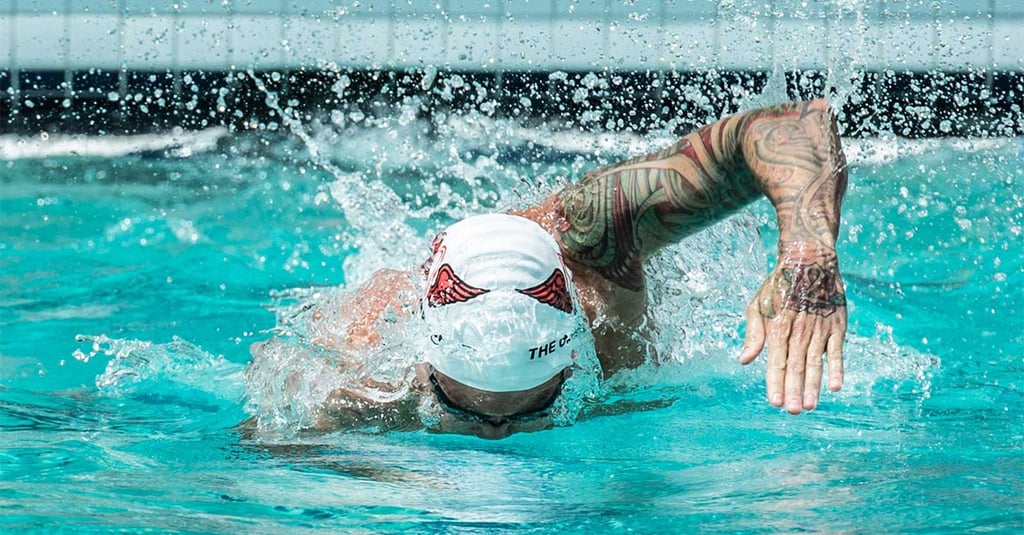4 Ways Swimming Helps Athletes in Other Sports

Aquatic sports tend to be categorized as unique in both their training methods and physiological demands on the athlete. Swimming, for example, places athletes in a buoyant environment that greatly affects their body awareness. Coordination in the water and coordination on land are incredibly different skills that require different training methods to develop. How, then, can swimming training benefit the football, baseball, or soccer player? Here are four key reasons why swimming can benefit land-based athletes:
1. Injury Prevention and Rehabilitation
First off, the goal of swim training for land-based athletes is not to excel in the pool, but rather to find some aspect of aquatic exercise that supplements the athlete’s existing training. A primary driver for aquatic training has to do with the benefit of low-impact exercise. With added buoyancy in the water, athletes are much more protected from joint and muscle injury than on land. As such, athletes battling chronic injuries on land may find respite from that pain in the water, and be able to bring greater intensity to their exercise. Swimming helps not only injured athletes, but also healthy athletes looking to prevent injury during the course of a long season. Alternating pool workouts with regular training on the field can improve the athlete’s range of motion, work different muscle groups, and contribute to greater overall fitness.
2. Establishing a Cardiovascular Baseline
In the preseason phase of most sports, there is a large emphasis on establishing a strong cardiovascular baseline using generalized fitness training. This is a great time to incorporate swimming workouts into a land athlete’s training, when sport-specific exercise is less of a priority than getting back into great shape. Swimming demands incredible cardiovascular endurance. Other cardio-based sports, like running and cycling, either create joint stress from high-impact movements or focus more on the lower body. Because non-swimmers are unaccustomed to cardio training in the pool, the new stimulus to the cardiovascular system will challenge the body in a different way.
3. Lung Capacity
Increasing lung capacity is one measure of cardiovascular fitness. Swim training will help athletes learn to hold their breath longer, but the key here is breath control. If athletes can perform high-intensity exercise with limited air (such as in swimming), their lung capacity will increase and their performance on land, with relatively limitless oxygen, will benefit from it. Athletes can measure their progress by paying attention to their heart rate. The best athletes can spike their heart rate and then quickly lower it. After each swim set, athletes should take their pulse and see how quickly they can get their heart rate back to baseline. Swimming exposes this particular trait very well.
4. Generalized Strength and Full Body Movements
Land-based athletes may consider swimming a purely cardio-based sport, but it places a high value on full body strength. Each stroke leads to greater range of motion around the shoulder joint and through the torso and hips, which is particular helpful for sports that demand rotational motion like baseball, golf, or even the throwing motion in football. Swimming demands core stability to be maximally efficient from fingertips to toes. Non-swimmers may find it hard at first to maintain a good bodyline in the buoyant environment, but it ultimately will improve core strength and help athletes transfer force efficiently from upper to lower body, and vice versa. Swimming incorporates the whole body and athletes will increase their strength to bodyweight ratio.
Recap
Swimming training is an effective way for land-based athletes to incorporate workouts that are gentle on joints and tough on the cardiovascular system. Swimming also works an athlete's entire body, exposes their strength to bodyweight ratio, and increases their range of motion. The sport of swimming isn’t for everyone, but a little swim training can help all athletes. To learn more about swimming check out these articles on 5 things to know about the swimmer's body and swimming-specific dryland training. 
About the Author

At Bridge, we are all athletes and coaches first. As athletes, our team has experienced everything from riding the pine on JV, to winning NCAA championships, to competing in the Olympic Games. As coaches, we have helped countless athletes reach their full potential, winning everything from age group section championships to Olympic Gold Medals.
Related Posts

The Best Bench Press Variation You’re...
This post is part of our Coaches Corner series with Taylor Rimmer. Taylor is NSCA-CPT, StrongFirst...

Does Powerlifting Harm Heart Health?
A recent study has discovered that a 12-week supervised strength training program (SSTP) may result...
-1.png)
Barefoot Running: Is It For You? |...
Run Free: Consider Less Cushion
Updated October 2020:
With more athletes looking for ways to...

